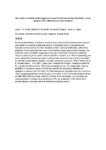Por favor, use este identificador para citar o enlazar este ítem:
http://www.alice.cnptia.embrapa.br/alice/handle/doc/1001184Registro completo de metadatos
| Campo DC | Valor | Lengua/Idioma |
|---|---|---|
| dc.contributor.author | WADT, L. H. de O. | pt_BR |
| dc.contributor.author | MUNARETTI, A. M. | pt_BR |
| dc.contributor.author | FONSECA, F. | pt_BR |
| dc.contributor.author | KAINER, K. A. | pt_BR |
| dc.date.accessioned | 2014-12-01T11:11:11Z | pt_BR |
| dc.date.available | 2014-12-01T11:11:11Z | pt_BR |
| dc.date.created | 2014-12-01 | pt_BR |
| dc.date.issued | 2014 | pt_BR |
| dc.identifier.citation | In: IUFRO WORLD CONGRESS, 24., 2014, Salt Lake. Sustaining forests, sustaining people: the role of research. Abstracts... Salt Lake: IUFRO, 2014. | pt_BR |
| dc.identifier.issn | 1465-5498 (impresso) / 2053-7778 (online). | pt_BR |
| dc.identifier.uri | http://www.alice.cnptia.embrapa.br/alice/handle/doc/1001184 | pt_BR |
| dc.description | Brazil nut (Bertholletia excelsa) is central to many Amazonian protected area reserves and resident extractivist livelihoods therein. Extractivists tend to concentrate nut harvests on trails worked by their ancestors and/or previous landholders, rather than integrate off-trail trees that may have more recently entered reproductive maturity. We tested an easily accessible mapping technology to potentially increase productivity simply by including more extant trees in collection routines. In a 145-ha landholding, we accompanied the resident harvester, tracking trails used and trees annually harvested to estimate current stand utilization. We also conducted a parallel 100% inventory of all B. excelsa trees ≥ 10 cm DBH, using linear transects 50 m apart. Results showed that the extractivist collected from 70% of all reproductive trees. The systematic mapping identified 54 new trees, some of which the extractivist had already identified as negligible producers. Still 32 of the 54 (59%) had good or tolerable crown forms and no vines, suggesting that they would be good producers. In 2013, this extractivist collected an estimated 3586 kg of nuts, visiting 125 trees. By incorporating 32 more trees, he could potentially increase his production by 27% (an additional ~USD 600 at 2013 prices) based on average diameter-informed production levels. | pt_BR |
| dc.language.iso | eng | eng |
| dc.relation.ispartofseries | (The International Forestry Review, v. 16, n. 5). | pt_BR |
| dc.rights | openAccess | eng |
| dc.subject | Produtos floretais não madeireiros | pt_BR |
| dc.subject | Castanheira | pt_BR |
| dc.subject | RESEX Chico Mendes | pt_BR |
| dc.subject | Acre | pt_BR |
| dc.title | An easily accessible technology to increase Brazil nut stand productivity: a case study in Chico Mendes Extractive Reserve. | pt_BR |
| dc.type | Resumo em anais e proceedings | pt_BR |
| dc.date.updated | 2014-12-01T11:11:11Z | pt_BR |
| dc.subject.thesagro | Bertholletia Excelsa | pt_BR |
| dc.subject.thesagro | Produtividade | pt_BR |
| dc.description.notes | Editado por: John A. Parrota; Cynthia F. Moser; Amy J. Scherzer; Nancy E. Koerth; Daryl R. Lederle. | pt_BR |
| riaa.ainfo.id | 1001184 | pt_BR |
| riaa.ainfo.lastupdate | 2014-12-01 | pt_BR |
| dc.contributor.institution | LUCIA HELENA DE OLIVEIRA WADT, CPAF-AC. | pt_BR |
| Aparece en las colecciones: | Resumo em anais de congresso (CPAF-AC)  | |
Ficheros en este ítem:
| Fichero | Descripción | Tamaño | Formato | |
|---|---|---|---|---|
| 25326.pdf | 104,7 kB | Adobe PDF |  Visualizar/Abrir |









